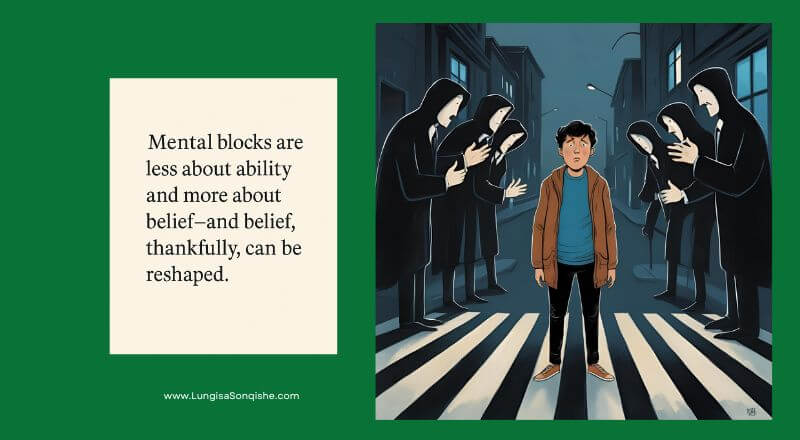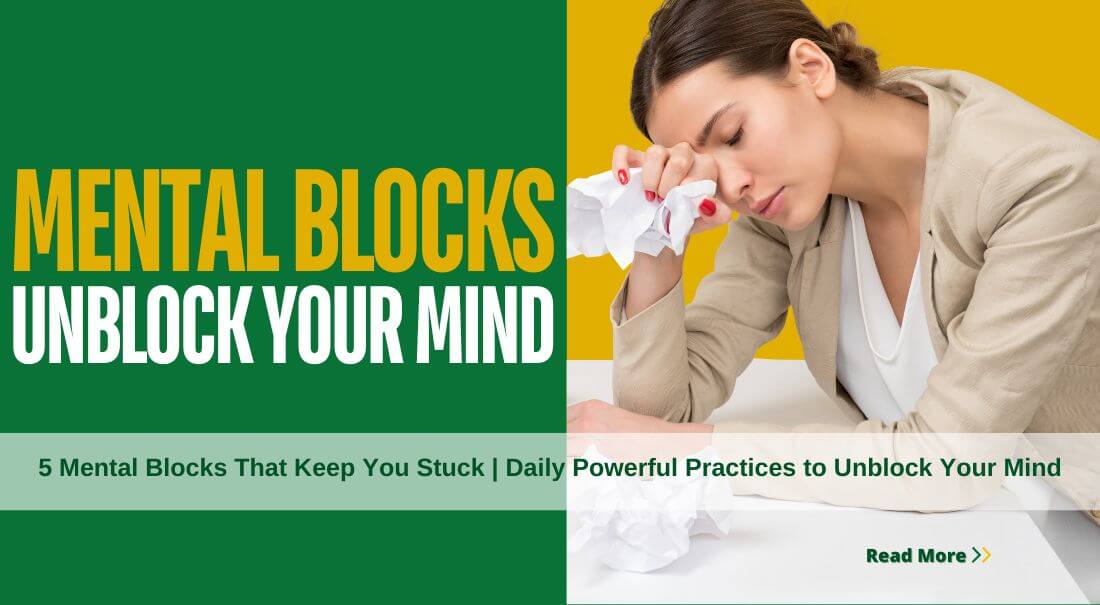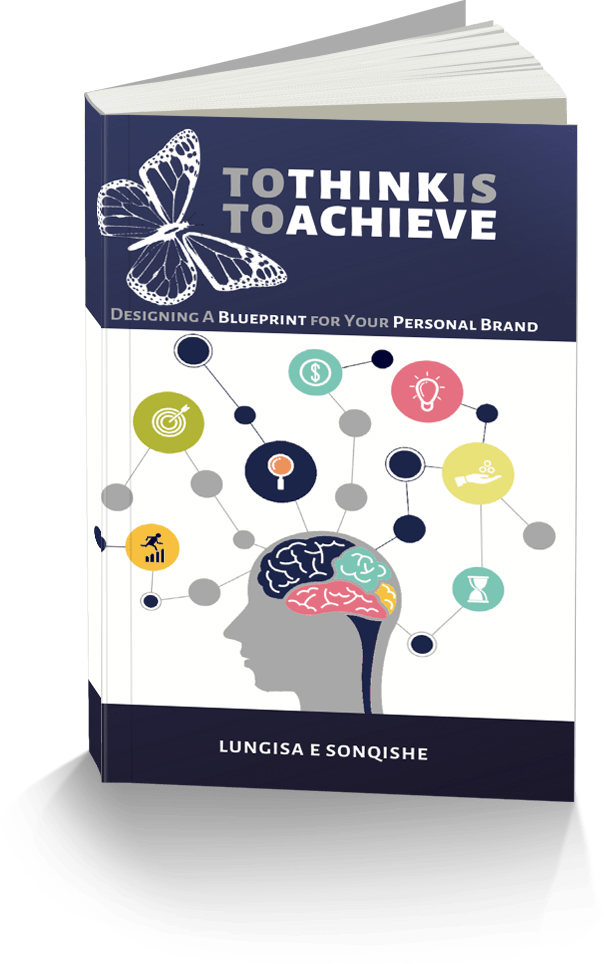Table of Contents
5 Mental Blocks That Keep You Stuck & Powerful Daily Practices
Introduction: Why We Get Stuck (and How to Get Unstuck)
We’ve all been there—sitting at the edge of an idea, a goal, or a much-needed decision but unable to move. You want to begin. You know you should. But somehow… you just don’t.
Feeling stuck can be one of the most frustrating experiences, especially when you’re driven, creative, or in a season of growth. It’s not always that you lack motivation. It’s not that you don’t care. It’s that something invisible is getting in the way—something inside.
This is what we call a mental block.
A mental block isn’t laziness or failure. It’s a protective mechanism. Often subconscious, it shows up when your mind senses emotional, physical, or social risk. It may stem from fear of failure, fear of judgment, past rejection, perfectionism, or simply being overwhelmed. Instead of letting you step forward, your nervous system pulls the brakes: “Not safe. Not ready. Stay here.”
These blocks don’t always come with sirens or prominent warnings. Sometimes, they arrive quietly:
– Endless overthinking.
– Constant procrastination.
– Sudden fatigue when it’s time to act.
– Harsh inner dialogue disguised as “realism.”
But here’s what’s powerful to remember:
“Mental blocks are less about ability and more about belief—and belief, thankfully, can be reshaped.”
You don’t need to have it all figured out or bulldoze through resistance. You simply need movement—small, gentle actions that nudge your system from freezing into flow. Over time, those tiny movements rebuild trust in yourself and create lasting momentum.
In the sections ahead, we’ll examine five common mental blocks that keep people stuck and the daily practices that can help loosen them. These aren’t quick hacks or rigid routines. They’re invitations—gentle, powerful ways to meet your mind compassionately and begin again without pressure.
Because getting unstuck doesn’t start with a breakthrough.
It starts with one breath. One step. One new thought.
Let’s begin.
🧠 Block #1 – The Perfectionism Trap

Mental blocks are less about ability and more about belief—and belief, thankfully, can be reshaped.
Perfectionism wears a convincing disguise. It often presents as ambition, high standards, or “just wanting to do it properly.” But more often than not, it’s fear in a tailored suit—fear of getting it wrong, looking foolish, or being criticised. And so, instead of beginning, you freeze. Instead of finishing, you overwork. And instead of celebrating progress, you obsess over flaws.
At its core, perfectionism is a defence mechanism. It says:
“If I can make this perfect, no one can judge me.”
But what it means is: “If it isn’t perfect, I’m not enough.”
This belief creates paralysis. You spend more time planning than doing, second-guess everything, wait for “the right moment” or “more clarity,” which never arrives, and let your ideas, dreams, and efforts gather dust.
What It Sounds Like:
- “I’m not ready yet.”
- “It has to be flawless before I share it.”
- “If it’s not excellent, it’s not worth doing at all.”
These thoughts don’t come from laziness—they come from fear. And fear, when unacknowledged, becomes a wall between you and your momentum.
Daily Practice: The 5-Minute Start Rule
To loosen perfectionism’s grip, the antidote is action without expectation. One of the most effective tools is the 5-Minute Start Rule:
Commit to doing a task—imperfectly—for just five minutes.
Tell yourself you’re not doing it to succeed. You’re doing it to begin.
Why it works:
- It lowers the emotional stakes.
- It bypasses the “all-or-nothing” trap.
- It teaches your nervous system that starting doesn’t equal danger.
More often than not, once you begin, the resistance softens. You’ll usually do more than five minutes, but you’ve still won even if you don’t. You’ve started, and that counts.
Supportive Reframes & Reminders:
- “Done is better than perfect.”
- “I can improve as I go.”
- “Progress, not performance, is what builds confidence.”
The next time you feel frozen at the edge of starting something, ask:
“Am I aiming for perfect, or am I allowing myself to grow?”
Choose growth—even if it’s messy, even if it’s slow. That’s where momentum lives.
🧠 Block #2 – Fear of Judgement

You don’t need to master your mind. You just need to move with it.
Few things keep us stuck as effectively as the fear of being seen—and misunderstood. The fear of judgment isn’t always about loud criticism or actual confrontation. More often, it’s subtle. It’s the quiet hesitation before sharing your ideas. The urge to shrink when you’re excited. The “what will they think?” loop that stops you from even trying.
At its root, this fear is deeply human. We’re wired for connection; our nervous systems interpret disapproval as danger. The mind equates it to emotional exile when we imagine being criticised, laughed at, or rejected.
So we stay quiet. We dim down. We choose safety over self-expression.
But here’s the problem: when fear of judgment drives, your voice stays parked, your creativity stays caged, and your momentum dissolves under the weight of “what if?”
What It Sounds Like:
- “People will think I’m not qualified.”
- “They’ll see me as arrogant, weird, or cringey.”
- “Who do I think I am to share this?”
These thoughts can be deeply ingrained, often rooted in past experiences—like childhood criticism, bullying, or environments where authenticity wasn’t welcomed.
Daily Practice: The Visibility Challenge
To soften this block, start building tolerance for visibility—on your own terms.
Each day, share one small, authentic thing with someone safe, publicly, or even just with yourself.
Examples:
- Post one honest sentence on social media.
- Tell a friend what you’re working on or dreaming of.
- Speak your opinion in a meeting, even if your voice shakes.
- Record a voice note reflecting on your truth—even if no one hears it but you.
This isn’t about proving yourself. It’s about proving to yourself that being seen doesn’t mean being shamed. That your voice, your vision, your self-expression—belong.
Journal Prompt:
“What part of me fears being seen—and what does it need to feel safe?”
Supportive Reframes & Reminders:
- “Being visible is vulnerable—and brave.”
- “My truth doesn’t need permission.”
- “If it helps even one person, it’s worth sharing.”
Fear of judgement doesn’t vanish overnight. But each small act of visibility weakens its grip. And each time you speak despite the tremble, your confidence grows—not from being fearless, but from being real.
🧠 Block #3 – Mental Overload & Overthinking
Progress doesn’t come from pressure—it comes from permission.
Sometimes, the problem isn’t that you don’t care or don’t know what to do—you care too much and think about everything at once. You spin your wheels in analysis. You second-guess every option. You mentally rehearse scenarios until your brain is too tired to act.
This is the block of mental overload—when the mind becomes so crowded that clarity disappears. You try to map out every possible path, outcome, or risk in advance. You convince yourself that you’ll feel more certain if you think harder.
But more thinking doesn’t always bring clarity. Often, it just brings exhaustion.
When your mind is overloaded, momentum dies because action feels dangerous. You get stuck in a loop: think →, overthink →, freeze →, feel guilty, → think some more. The result? No progress, and a growing sense of frustration.
What It Sounds Like:
- “What if I choose wrong?”
- “I just need to figure everything out first.”
- “Let me plan a bit more before I start.”
These are fear-based thoughts disguised as strategy. The brain is trying to protect you from uncertainty—but in doing so, it blocks forward motion.
Daily Practice: The Mind Dump + 1-3-1 Method
The fastest way to calm an overloaded mind is to offload it. Take the swirling thoughts out of your head and onto paper—where they can be seen, sorted, and softened.
Step 1: Mind Dump
Each morning or evening, spend 5–10 minutes writing down everything in your head. No editing. No judgment. Just spill. Thoughts, worries, ideas, reminders—everything.
Step 2: 1-3-1 Method
After dumping your thoughts, write:
- 1 thing you’ve been avoiding
- 3 micro-actions you could take toward it
- 1 action you’ll commit to doing today
This shifts you from thinking mode to doing mode. It restores a sense of control and helps the brain stop looping.
Supportive Reframes & Reminders:
- “I don’t need to know everything to begin.”
- “Clarity comes through action, not just thought.”
- “Small steps clear the fog.”
Mental overload is a symptom of caring, not failure. But your mind needs boundaries—and your energy needs direction. The goal isn’t to silence your thoughts but to structure them, so they serve your momentum rather than sabotage it.
🧠 Block #4 – Old Stories & Inner Critic Narratives
Perfectionism is fear in a tailored suit—it looks sharp but keeps you frozen.
Sometimes, the block isn’t what’s happening now but what you still believe from then.
We all carry inner stories—beliefs shaped by past experiences, repeated messages, or painful moments. Over time, these stories become internal truths, even when they no longer serve us. And the more we repeat them, the more they shape what we believe we can do or become.
These are the whispers of the inner critic:
“You always mess things up.”
“You’re not creative.”
“You’re too much.”
“You’re not enough.”
These aren’t facts—they’re emotional echoes. But if left unchallenged, they become powerful barriers that block momentum, motivation, and self-worth.
The tricky part? These narratives are often quiet, familiar, and automatic. You don’t hear them as stories—you hear them as truth. That’s why they’re so effective at keeping you stuck.
What It Sounds Like:
- “I’m not the kind of person who finishes things.”
- “Other people are more capable than me.”
- “I’ve failed before; I’ll probably fail again.”
These thoughts tend to replay just as you’re about to take a step forward—because that’s when the brain gets nervous and tries to protect you from possible pain by pulling you back into the past.
Daily Practice: Reframe & Rewrite the Script
The goal isn’t to silence your inner critic—it’s to challenge it and speak back with truth, compassion, and choice.
Step 1: Notice the story
Write down a limiting thought when it arises. Ask:
“Whose voice is this really?”
“Is this always true—or just familiar?”
Step 2: Reframe it kindly
Turn the critical thought into a more compassionate and honest version.
From: “I never follow through.”
To: “I’ve struggled in the past, but I’m learning to support myself differently now.”
From: “I’m too late.”
To: “I’m right on time for who I’m becoming.”
Supportive Reframes & Reminders:
- “That was a past version of me. I’m allowed to grow beyond it.”
- “This thought is familiar—but not final.”
- “I’m the narrator now.”
Your inner narrative shapes your outer reality. When you change the way you speak to yourself—even slightly—you begin to unlock the version of you that’s been waiting underneath all along.
🧠 Block #5 – Emotional Avoidance
You don’t need to smash through every block at once—just soften one, gently, each day.
A particular kind of stuckness doesn’t come from what you think but from what you are not feeling.
We all experience emotional discomfort: fear, sadness, uncertainty, and shame. But instead of facing those emotions head-on, we often avoid them—not because we’re weak, but because we’re human. Avoiding discomfort can make you feel safer than walking through it.
This avoidance creates a mental block. You don’t act because the action might trigger a feeling you’re not ready to deal with. So you delay. You distract. You numb yourself by over-planning, over-scrolling, overeating—or doing everything but the thing that matters.
Over time, this emotional backlog becomes a silent weight on your nervous system. It takes energy to avoid what’s unresolved. And eventually, that avoidance looks like procrastination, indecision, or “I don’t know why, but I just can’t do it.”
What It Sounds Like:
- “I’ll deal with this later.”
- “I’m fine. It’s not that deep.”
- “I just don’t feel like doing anything right now.”
The truth is: you’re not lazy—you’re protecting yourself. But the longer emotions stay buried, the more they block your forward motion.
Daily Practice: The Emotion Check-In
One of the most powerful things you can do is simply pause and ask:
“What am I actually feeling right now?”
You don’t have to fix it. You just need to name it.
Step 1: Name the feeling
Use a prompt like:
“Right now, I feel ____, and that’s okay.”
This gives your emotional body permission to exist without shame.
Step 2: Regulate
Support your system with grounding techniques:
- 4-7-8 breathing (inhale 4, hold 7, exhale 8)
- A mindful walk, noticing colours or textures
- Placing a hand on your heart or belly and simply breathing there
This creates internal safety—and from safety, momentum becomes possible again.
Supportive Reframes & Reminders:
- “Feeling is not failing.”
- “This emotion is energy—it wants to move through, not take over.”
- “I can feel this and still take one small step.”
We don’t need to conquer our emotions to make progress.
We just need to include them. When you make space for how you feel, you soften resistance—and the path forward starts to clear.
Integration: Momentum Over Mastery
If there’s one message to carry forward from all of this, let it be this:
You don’t need to master your mind. You need to move with it.
Mental blocks are not evidence that you’re broken. They are signs that something inside you is calling for attention—an old belief, a buried fear, a part of you simply trying to feel safe. And that part doesn’t need punishment or pressure. It needs presence. It needs permission.
The truth is that getting unstuck rarely comes from pushing harder. It comes from noticing where you’ve frozen and then choosing one small, meaningful step toward flow.
Whether your block is perfectionism, fear of judgement, overthinking, outdated beliefs, or emotional avoidance, the practices you’ve explored here are not quick fixes. They are daily invitations to return to yourself with care and clarity.
So here’s your gentle challenge:
💡 Choose one block that resonated most with you.
💡 Commit to one practice this week—just five minutes a day.
💡 Notice what shifts—not just in your output but in your relationship with yourself.
Progress isn’t loud. It’s subtle.
It often sounds like a softer voice in your head.
It feels like showing up, even when you’re unsure.
It looks like grace, not grit.
Closing Thought
“You don’t need to smash through every block at once—just soften one, gently, each day.”
You are not behind.
You are not alone.
You are not stuck—you are becoming.
And with each conscious breath, each tiny action, you are building something far more potent than momentum.
You are building trust in yourself.
Would you like this format into a shareable doc, a carousel for Instagram, or a worksheet version of the five blocks and practices? I’d be happy to help.
Book Recommendations
- The War of Art by Steven Pressfield – On resistance and how to move through creative paralysis.
- The Mountain Is You by Brianna Wiest – Transforming self-sabotage into growth and emotional clarity.
- Radical Acceptance by Tara Brach – Meeting fear and resistance with mindfulness and compassion.
- Self-Compassion by Kristin Neff – Practical methods for shifting from harsh inner talk to encouragement.
- The Gifts of Imperfection by Brené Brown – Releasing the need to perform, perfect, or prove.
- Chatter by Ethan Kross – The science of inner dialogue and how to harness your inner voice.
- Atomic Habits by James Clear – Building momentum through tiny, consistent behavioural changes.

Find Out More & Book a Session
About Lungisa E Sonqishe
ELEVEN11:Mindset+ : eleven11mindsetplu.com



























